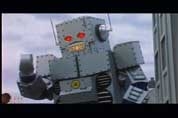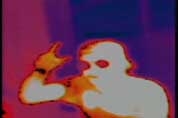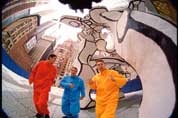DVD Insider: Beastie Boys Page 2
The Robot vs. the Octopus  We kick off our screening with the band's homage to Japanese monster movies, switching the projector to letterboxed mode to accommodate the 1.85:1 image. The 5.1 mix uses excerpts from Schoenberg's atonal Variations for Orchestra combined with a generous dose of effects, which really spice things up. When the robot works his break-dance moves in the center of the cardboard-cutout Tokyo, his footfalls have a gut-grabbing dynamic impact. At Adam's suggestion, we also watch the video with its effects-only alternate audio track, which allows us to take in the T2-style mix. As an audio accompaniment to the stumbling movements of guys in cheap-looking costumes, it's quite a hoot.
We kick off our screening with the band's homage to Japanese monster movies, switching the projector to letterboxed mode to accommodate the 1.85:1 image. The 5.1 mix uses excerpts from Schoenberg's atonal Variations for Orchestra combined with a generous dose of effects, which really spice things up. When the robot works his break-dance moves in the center of the cardboard-cutout Tokyo, his footfalls have a gut-grabbing dynamic impact. At Adam's suggestion, we also watch the video with its effects-only alternate audio track, which allows us to take in the T2-style mix. As an audio accompaniment to the stumbling movements of guys in cheap-looking costumes, it's quite a hoot.
So Wat'cha Want  "So Wat'cha Want" is a favorite video of mine, and I ask Adam about the grungy '80s-style keying effect, which seems a prime example of the Beastie Boys' iconoclastic visual style. When this video first aired, in 1992, many directors were adopting slick production values that made their videos indistinguishable from the commercials they were sandwiched between. In contrast, "So Wat'cha Want" seems more like a throwback to MTV's commercial-free days, when directors were having fun with the medium.
"So Wat'cha Want" is a favorite video of mine, and I ask Adam about the grungy '80s-style keying effect, which seems a prime example of the Beastie Boys' iconoclastic visual style. When this video first aired, in 1992, many directors were adopting slick production values that made their videos indistinguishable from the commercials they were sandwiched between. In contrast, "So Wat'cha Want" seems more like a throwback to MTV's commercial-free days, when directors were having fun with the medium.
 But Adam's explanation of what the band was trying to achieve turns my theoretical context on its head. "There's this movie Wolfen with the point of view of a werewolf, and it's this weird thing where the night sky turns to daylight. It's a cheesy effect, and I like how it looked." We switch over to watching one of the alternate video tracks, a little something called Thermal Cam that paints the band in the orange, yellow, and pink hues of a solar flare. As far as alternate "angles" go, this one suggests a previously unexplored psychedelic side to the Beasties' music.
But Adam's explanation of what the band was trying to achieve turns my theoretical context on its head. "There's this movie Wolfen with the point of view of a werewolf, and it's this weird thing where the night sky turns to daylight. It's a cheesy effect, and I like how it looked." We switch over to watching one of the alternate video tracks, a little something called Thermal Cam that paints the band in the orange, yellow, and pink hues of a solar flare. As far as alternate "angles" go, this one suggests a previously unexplored psychedelic side to the Beasties' music.
Alive Adam requests that we switch over to "Alive" and explore its large selection of alternate tracks. With nine video and seven audio options to choose from, you could kill a whole afternoon sorting through all the combinations. I'm intrigued by the title of one of the alternate video tracks: "Dubuffet." Adam explains that it refers to the artist who built the public sculpture that the Beasties used as one of the video's shoot-and-run backgrounds. (The band apparently has a bad habit of filming in public spaces without getting permits.)
 We choose the video's Moby audio remix and take in the concoction that results: three guys in brightly colored pajamas bouncing around a sculpture by a guy who sought inspiration in the art of mental patients. Moby's remix of the song is a far cry from the album version - smooth, playful, and considerably more melodic. The arrangement nicely complements the Boys' fuzzy costumes, which Adam, a new dad at the time, explains on the commentary were inspired by the Sesame Street character Elmo.
We choose the video's Moby audio remix and take in the concoction that results: three guys in brightly colored pajamas bouncing around a sculpture by a guy who sought inspiration in the art of mental patients. Moby's remix of the song is a far cry from the album version - smooth, playful, and considerably more melodic. The arrangement nicely complements the Boys' fuzzy costumes, which Adam, a new dad at the time, explains on the commentary were inspired by the Sesame Street character Elmo.
Gratitude (Live Version) When we ask Adam which of the director's commentaries is his favorite, he leads us to the one on the live version of "Gratitude" - which turns out to be no ordinary commentary. In what essentially amounts to a crank phone call, a Criterion producer leads director Ari Marcropoulos through an absurd conversation about everything from recurring barn-raising motifs in Beastie Boys videos (not surprisingly, Marcropoulos has little to say about this subject) to the pleasures of Internet chat rooms.
Next, Adam suggests we check out the alternate Oscilloscope Angle. As the name suggests, the visuals here are pretty minimal: a continuous close-up of patterns on a test instrument's display screen generated by the sound waves of the music. This one won't be making the MTV rotation anytime soon.








































